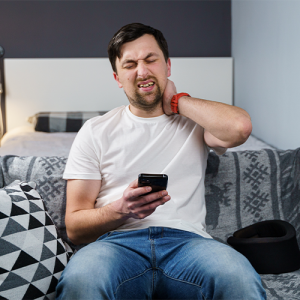Text Neck: Signs & Symptoms
Worldwide, the use of cell phones is estimated to be 6 billion, with the current population at 7.5 billion, it means about 7 among 10 use a cell phone, youngsters being more into their use, with compulsive checking every 10min, using late nights and immediately on waking up being highly common. In a day the cumulative time spent on scrolling and typing is reportedly about 3 hours, which can go up to 8 or 10 hours on free days(no school/work).

Bending head to 15 degrees needs about 10kg of weight to be counterbalanced by the muscles of the neck, upper back, and shoulders, while at 30 to 45 degrees, the common angulations needed to do texting activity causes stress of about 17- 23 kg, repetitively, injuring to muscles and joints of the spine in the neck, upper back, and shoulders.
What is Text Neck –
Text Neck is a term used to describe the pain caused by texting that begins in the neck and upper back.
Text Neck is a developing issue on the grounds that countless individuals, including kids, are constantly using smartphones, iPads, handheld computers, and video games.
Text Neck Treatment & Prevention –
Raise the phone –
Raise the phone. Move the phone, tablets, ipads, etc… up to eye level so the head does not need to be shifted forward or the neck needs to be bent forward
Take Regular Breaks –
Avoid using your phone for some time. Try any type of head-forward posture. If necessary, use an alert or application to set automatic reminders to take breaks from handheld gadgets.
Stand up straight –
Correct posture, with the chin, raised up and shoulders pulled back, keeps the body adjusted in a neutral position.
Work-out routinely. A solid, flexible back and neck are more ready to handle additional stress.
Some research demonstrates that youngsters who are dynamic in low-impact team activities or high-intensity sports are less likely to have neck pain.
For detailed stretches, check out our guide on Exercises to Relieve Neck Pain
How long does it take to heal from Text Neck?
Text neck can be cured. Recovery generally takes around four to eight weeks yet requires continued self-awareness.
However, the healing time can change significantly depending on the severity of your condition and the consistency of your treatment plan.
Dr. Ganesh Explains Text Neck – Causes, Symptoms & Recovery Tips
With the increasing use of smartphones and screens, Text Neck is becoming a modern health concern. But what exactly is it—and how do you know if you have it?
In this expert video, Dr. Ganesh Veerabhadraiah, one of Bangalore’s leading neurosurgeons, breaks down the condition in simple terms. With 20+ years of experience in spine and neurological care, Dr. Ganesh is widely respected for his expertise in treating posture-related spinal issues like Text Neck
You’ll Learn in This Video:
• What causes Text Neck and how screen habits affect your spine
• Early signs and symptoms you shouldn’t ignore
• Simple techniques to reduce strain and improve posture
Tap the video below to watch now:
FAQs:
1.What is Text Neck?
Text Neck is a modern condition caused by prolonged bending of the neck while looking at mobile devices, leading to neck pain, stiffness, and spinal misalignment.
2. What are the early symptoms of Text Neck?
Common symptoms include neck stiffness, shoulder tightness, headaches, and upper back pain—especially after extended screen use.
3. Can Text Neck lead to long-term damage?
Yes. If untreated, it can cause disc degeneration, pinched nerves, or chronic posture issues over time.
4. How can I prevent or treat Text Neck?
Limit screen time, maintain upright posture, do regular neck stretches, and seek guidance from a spine specialist if symptoms persist.



